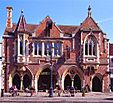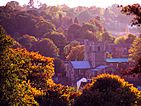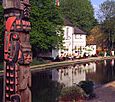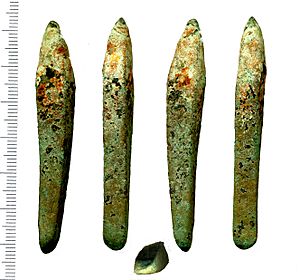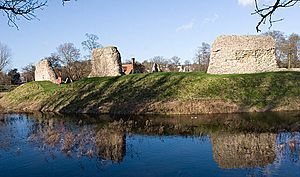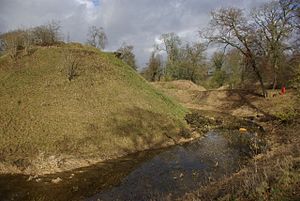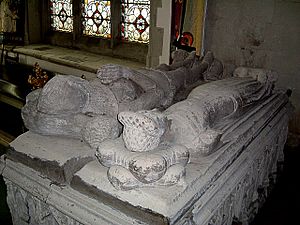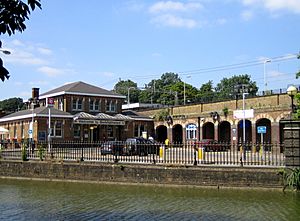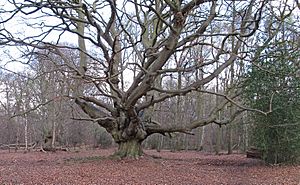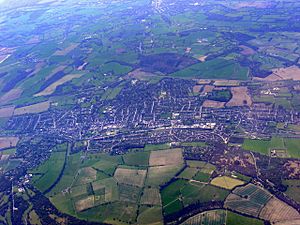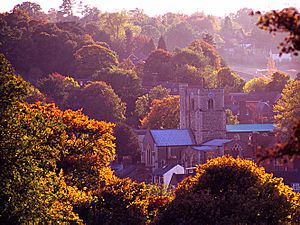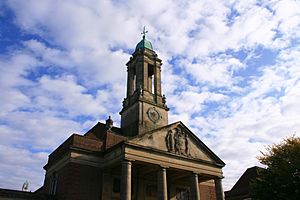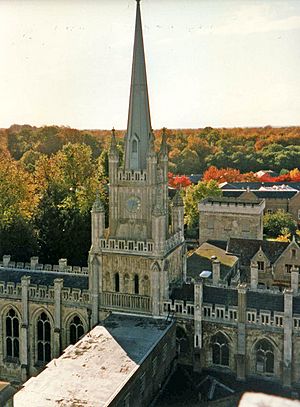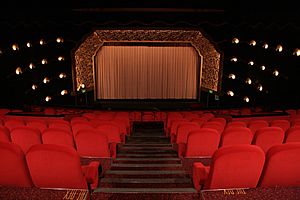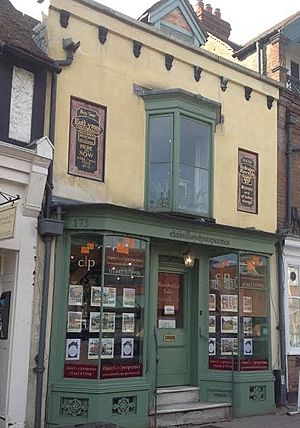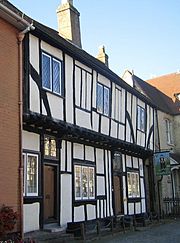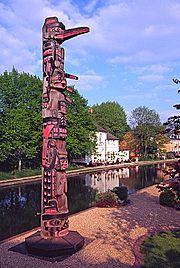Berkhamsted facts for kids
Quick facts for kids Berkhamsted |
|
|---|---|
| Town | |
|
Berkhamsted. From top to bottom: Berkhamsted Old Town Hall, St Peter's Church, Berkhamsted Castle, Ashridge, Berkhamsted Totem Pole and Grand Union Canal, Berkhamsted High Street
|
|
 Coat of arms |
|
| Population | 18,500 (mid-2016 est.) |
| OS grid reference | SP993077 |
| District |
|
| Shire county | |
| Region | |
| Country | England |
| Sovereign state | United Kingdom |
| Post town | BERKHAMSTED |
| Postcode district | HP4 |
| Dialling code | 01442 |
| Police | Hertfordshire |
| Fire | Hertfordshire |
| Ambulance | East of England |
| EU Parliament | East of England |
| UK Parliament |
|
Berkhamsted (pronounced BUR-kəm-sted) is a cool historic town in Hertfordshire, England. It sits in the Bulbourne valley, about 26 miles (42 km) northwest of London. It's a civil parish with its own town council. The town is surrounded by beautiful countryside, much of it in the Chiltern Hills, which is a special Area of Outstanding Natural Beauty.
The main street, called the High Street, follows an ancient route from before Roman times. It was known as Akeman Street by the Saxons. Berkhamsted was first written about in 970. In 1086, the Domesday Book called it a burbium, meaning an old town.
A very important event happened here in December 1066. After William the Conqueror won the Battle of Hastings, the English leaders gave up to him at Berkhamsted. This moment was written down in the Anglo-Saxon Chronicle. From 1066 to 1495, Berkhamsted Castle was a favorite home for kings and famous people. These included King Henry II, Edward, the Black Prince, and even Geoffrey Chaucer, who wrote The Canterbury Tales.
In the 1200s and 1300s, Berkhamsted was a busy town for wool trading. It had a lively local market. The oldest timber-framed building in Great Britain, built between 1277 and 1297, is still a shop on the High Street today.
After the castle was left empty in 1495, the town became less important. It lost its special town status in the 1600s. Famous people born here include Colonel Daniel Axtell, who was involved in the trial of King Charles I. Berkhamsted started growing again in the 1800s when the canal and railway were built. Today, it's a wealthy town where many people live and travel to work in London.
Berkhamsted has links to famous writers like William Cowper, Maria Edgeworth, and Graham Greene. It also has cool places like The Rex, a popular independent cinema. The British Film Institute's BFI National Archive is also nearby. It's one of the biggest film and TV archives in the world.
The town has several schools. Berkhamsted School is a private school started in 1541. Ashlyns School is a state school with a history going back to the Foundling Hospital in London, which helped abandoned children. There's also Ashridge Executive Education, a business school in the amazing Ashridge House.
Contents
- Exploring Berkhamsted's Past
- Berkhamsted Today: Location and Environment
- How Berkhamsted is Governed
- Who Lives in Berkhamsted?
- Getting Around Berkhamsted
- Shopping and Jobs in Berkhamsted
- Learning in Berkhamsted
- Places of Worship
- Fun Things to Do in Berkhamsted
- Media in Berkhamsted
- Cool Places to See
- People Connected to Berkhamsted
- See also
Exploring Berkhamsted's Past
What's in a Name?
The town's name first appeared in the 900s as Beorhðanstædæ. The first part, Bearroc, might mean "hilly place" in Old Celtic. Or it could come from Old English words for "hill" (beorg) or "birch tree" (berc or beorc). The "hamsted" part means "homestead". So, Berkhamsted could mean "homestead among the hills" or "homestead among the birches".
A local historian found over 50 different ways the town's name has been spelled! The current spelling was chosen in 1937. People sometimes call the town "Berko" for short.
Ancient Times: Prehistoric and Roman Life
People have lived in the Berkhamsted area for over 5,000 years. We know this from tools and items found from the Neolithic (New Stone Age), Bronze Age, Iron Age, and Roman times. For example, many flint chips show that people made stone tools here long ago.
There are also old earthworks called Grim's Ditch on both sides of the valley. These were built in the late Bronze Age or Iron Age. Before the Romans arrived, the area was home to the Catuvellauni tribe.
The Bulbourne Valley had lots of wood and iron ore. In the late Iron Age, a big area near Northchurch became a major iron-making center. The town's main street still follows the path of the Roman road, Akeman Street. This road connected important Roman towns like St Albans (Verulamium) and Cirencester (Corinium).
Romans also built large farms with fancy villas in the area. Remains of these villas have been found near Northchurch and Frithesden.
Anglo-Saxon Beginnings
The first time Berkhamsted was mentioned in writing was in the will of Queen Ælfgifu in 970 AD. She left large estates, including Berkhamsted, to others. Pottery from the 600s and water mills from the late 800s show that an Anglo-Saxon settlement existed where modern Berkhamsted is now.
The nearby church of St Mary's in Northchurch might have been a very important church connected to a high-status Anglo-Saxon estate. This estate later became part of the Berkhamsted area after the Normans arrived.
The Norman Conquest and Domesday Book
In December 1066, a huge event happened in Berkhamsted. After William the Conqueror won the Battle of Hastings, he marched his army around London. At Berkhamsted, the English leaders, including Edgar the Atheling (who was supposed to be the next king), gave up to William. We don't know exactly why Berkhamsted was chosen, but it was a good defensive spot northwest of London.
After this, William was crowned King on Christmas Day, 1066. He gave the "Honour of Berkhamsted" to his half-brother, Robert, Count of Mortain. Robert became one of the biggest landowners in England. He built a wooden fort here, which later became the famous Berkhamsted Castle.
The Domesday Book in 1086 described Berkhamsted as a burbium (an old town). It had enough land for many farms, two flour mills, and a vineyard. It also recorded 52 "burgesses," who were likely involved in trade. This shows that Berkhamsted was planned to be both a trading and a defensive center.
Berkhamsted Castle: A Royal Home (11th to 15th Centuries)
Berkhamsted Castle is a great example of an 11th-century Norman castle. It was a fancy home and a center for managing large estates. The castle created jobs for local people, both inside the castle and in the large deer park and vineyard. For almost 400 years, the royal family's support helped the town grow and become important.
Many famous people lived in or visited the castle. King Henry I took it from Robert's son. Later, Henry II gave it to his friend Thomas Becket. Henry II loved the castle and used it often. Both King Richard I and King John gave the castle to their queens.
In King John's time, Geoffrey Fitz Peter was in charge of Berkhamsted. He helped build the new parish church of St Peter, which shows how the town was growing. He also set up two hospitals. In December 1216, the castle was attacked during a civil war and captured after 20 days.
Later, Henry III's brother, Richard, was given the castle. He made it a grand home and a center for his lands. Richard's family crest is even part of Berkhamsted's town crest today. His son, Edmund, 2nd Earl of Cornwall, started Ashridge Priory, a religious college, in 1283.
Edward I and his son Edward II also owned the castle. Edward III gave it to his son, Edward, the Black Prince. The Black Prince made the hunting grounds even bigger. It's a tradition that Berkhamsted Castle still belongs to the oldest son of the English monarch.
The castle was also used to hold royal prisoners, like John II of France. In 1361, the Black Prince and Joan of Kent spent their honeymoon here. Local archers from Berkhamsted fought bravely with the Black Prince at the Battle of Crecy.
Geoffrey Chaucer, the famous writer, worked on renovations at the castle in the late 1300s. He might have met people here who inspired characters in his Canterbury Tales. Kings Henry IV, Henry V, and Henry VI also owned the castle. The last person to live there was Cecily Neville, Duchess of York, mother of King Edward IV.
In 1833, Berkhamsted Castle became the first building in the UK to be officially protected. Sadly, part of it was destroyed in 1834 when the railway was built. Since the 1930s, English Heritage has looked after the castle ruins, and they are open for everyone to visit.
A Busy Medieval Market Town (12th to 15th Centuries)
The town grew around the old Akeman Street, south of the castle. In 1156, Henry II officially made Berkhamsted a town with a royal charter. This meant it had special laws and customs, and its merchants didn't have to pay tolls. The charter also said no other market could be set up within 7 miles (11 km) of Berkhamsted.
Berkhamsted became an important trading center in the 1100s and 1200s. It received more royal charters, which helped its trade. The growing wool trade brought a lot of wealth to the town until the early 1500s.
The town's market is its oldest institution, recognized by a royal charter in 1217. Medieval Berkhamsted had many different jobs. In the early 1200s, there were painters, a goldsmith, tailors, brewers, blacksmiths, carpenters, and even wine producers. Later, there were butchers, bakers, shoemakers, dyers, and many more.
By 1307, Berkhamsted was a large town with about 2,000 to 2,500 people. Some of the houses from this time, like 173 High Street, are still standing. In the 1300s, Berkhamsted was considered one of the "best" market towns in the country.
The founding of Ashridge Priory in 1283 also helped the town. Pilgrims from all over Europe came through Berkhamsted to see a holy relic at the priory. The town even sent two members to parliament in the 1300s.
Decline and Rebirth (16th to 20th Century)
In the 1500s, Berkhamsted became less important after the castle was abandoned. Nearby Hemel Hempstead grew bigger. Stone from the castle was used to build other buildings, like Berkhamsted Place and a local school. Brewing and malt-making were important industries.
In the 1600s, King James I confirmed Berkhamsted's town status with a new charter. However, parts of the common land were enclosed, meaning they were fenced off. The castle's large park also became much smaller.
Colonel Daniel Axtell, born in Berkhamsted, was a key figure in the English Civil War. He was involved in the trial of King Charles I. After the king's family returned to power, Axtell faced consequences for his actions. The town then lost its special town status.
Modern Growth: The 19th Century
In the 1700s and 1800s, Hemel Hempstead was the main town. But with the Industrial Age, Berkhamsted started to grow again. It was in a good spot between London and the industrial Midlands. New roads, canals, and railways helped the town expand.
The Grand Junction Canal reached Berkhamsted in 1798. This canal allowed for easy transport of goods like coal, grain, and building materials. It led to new industries like timber, malt, and boat building. Berkhamsted became a center for making barges for the canal. The area near the canal is still called the "Port of Berkhamsted."
In 1834, the first railway station was built. The railway helped the town's population grow even more. By 1851, the population was 3,395. New housing areas were built as large estates were sold off.
Industries in the 1800s included:
- Timber: Making wooden products like lance poles and tent pegs.
- Brush making: An offshoot of the timber industry.
- Watercress: Growing watercress in beds along the River Bulbourne.
- Chemicals: William Cooper developed a famous sheep-dip.
- Nurseries: Henry Lane's plant nursery became a big employer.
- Iron working: James Wood set up an ironworks.
Helping the Poor
In the 1800s, there were places called "workhouses" for poor people. Berkhamsted had one, and later, a larger one was set up. In 1841, the Countess of Bridgewater built a soup kitchen inside Berkhamsted Castle for the local poor. It helped about 15% of the town's population during winter.
The Battle of Berkhamsted Common
In 1866, a big dispute happened over Berkhamsted Common. Lord Brownlow, who owned Ashridge House, tried to fence off the common land and claim it as his own. But people like Augustus Smith and George Shaw-Lefevre fought back. They organized people to pull down the fences. This event became known as the "Battle of Berkhamsted Common."
Lord Brownlow took Smith to court, but the judge ruled in favor of Smith. This important legal decision helped protect common lands across the country. Today, the common is looked after by the National Trust.
World War I and Beyond
During the First World War, Berkhamsted Common was used to train soldiers. Over 12,000 men from the legal profession trained here before going to fight. They even dug 8 miles (13 km) of practice trenches, and some of them can still be seen today.
After the war, more housing was built. Many old industries in Berkhamsted closed down as more people started traveling to other towns for work.
In 1946, the nearby town of Hemel Hempstead was made a "New Town" to help with London's growing population. This led to Hemel Hempstead becoming much larger. In 1974, Berkhamsted became part of the new Dacorum district, which is based in Hemel Hempstead.
Berkhamsted Today: Location and Environment
Berkhamsted is about 26 miles (42 km) northwest of London, nestled in the Chiltern Hills. These hills are made of chalk and formed millions of years ago. The town is in a narrow valley that slopes from 180 meters (590 ft) down to 105 meters (344 ft) above sea level.
The River Bulbourne, a special type of river called a "chalk stream," flows through the valley. It starts near Dudswell and Northchurch and runs through Berkhamsted. The river used to create marshy areas, but the canal helped drain them. It also powered watermills and filled the moats of Berkhamsted Castle.
The center of Berkhamsted looks like a medieval market town. The long High Street follows the old Roman road. Over the years, many different buildings have been added, some dating back to the 1200s. The town grew a lot after the Grand Junction Canal was built in 1798 and the railway in 1836–37.
Today, Berkhamsted is known as a pleasant and wealthy town. A large part of it is protected as a conservation area.
The countryside around Berkhamsted is part of the Green Belt and the Chilterns Area of Outstanding Natural Beauty. On the northeast side of town are the Berkhamsted and Northchurch commons, which are huge open spaces. These commons are managed by the National Trust and Berkhamsted Golf Club. Beyond the common is Ashridge, a large historic parkland that was once part of Berkhamsted Castle's hunting grounds. It's now managed by the National Trust and is an important nature area.
Nearby Places
Berkhamsted is surrounded by several other towns and villages:
- Tring (Northwest)
- Little Gaddesden (North)
- Great Gaddesden (Northeast)
- Wendover (West)
- Hemel Hempstead (East)
- Great Missenden (Southwest)
- Chesham (South)
- Bovingdon (Southeast)
Local villages include:
- Bourne End
- Nettleden
- Frithsden
- Potten End
- Aldbury
- Ringshall
- Little Gaddesden
- Great Gaddesden
- Northchurch
- Cow Roast
- Ashley Green (in Buckinghamshire)
Berkhamsted's Weather
Berkhamsted has a typical British climate, meaning it's generally mild with rain throughout the year.
| Climate data for Berkhamsted | |||||||||||||
|---|---|---|---|---|---|---|---|---|---|---|---|---|---|
| Month | Jan | Feb | Mar | Apr | May | Jun | Jul | Aug | Sep | Oct | Nov | Dec | Year |
| Mean daily maximum °C (°F) | 6 (43) |
7 (45) |
10 (50) |
12 (54) |
16 (61) |
19 (66) |
21 (70) |
22 (72) |
18 (64) |
14 (57) |
9 (48) |
6 (43) |
13 (55) |
| Mean daily minimum °C (°F) | 3 (37) |
3 (37) |
4 (39) |
5 (41) |
8 (46) |
10 (50) |
12 (54) |
13 (55) |
11 (52) |
8 (46) |
5 (41) |
3 (37) |
7 (45) |
| Average precipitation mm (inches) | 69.3 (2.73) |
59.4 (2.34) |
46.5 (1.83) |
70.1 (2.76) |
58.1 (2.29) |
58.9 (2.32) |
46.0 (1.81) |
68.9 (2.71) |
51.7 (2.04) |
84.3 (3.32) |
93.9 (3.70) |
80.9 (3.19) |
788.0 (31.02) |
You can find up-to-date weather information for Berkhamsted on the Met Office Weather Observation Website.
How Berkhamsted is Governed
Berkhamsted is part of the Harpenden and Berkhamsted area for the UK Parliament. The current MP is Victoria Collins from the Liberal Democrats.
The town has a town council, which is the first level of local government. It represents the people of Berkhamsted to two higher levels: Dacorum Borough Council and Hertfordshire County Council. The Dacorum district is based in Hemel Hempstead. Berkhamsted makes up about 12% of Dacorum's population.
Berkhamsted is divided into three local government areas called Wards: East, West, and Castle. In recent elections, the Liberal Democrats have won the most seats on the town council.
A Look at Local Government History
Berkhamsted used to be an "ancient borough" but lost that status in the 1600s. For a long time, it was governed by its parish vestry, like most rural areas. In 1835, Berkhamsted became the center of a "poor law union," which helped manage support for poor people in the area.
In 1898, Berkhamsted became an "Urban District," which meant it had its own local council separate from the rural areas. This council was first called the "Great Berkhampstead Urban District." In 1937, the name was officially changed to "Berkhamsted Urban District" because it was easier to say and find.
The Berkhamsted Urban District Council had its offices and meeting place at 135 High Street. In 1938, they built the new Berkhamsted Civic Centre at 161 High Street, which is still used today.
In 1974, the Berkhamsted Urban District was abolished. It became part of the new Dacorum district. The Berkhamsted Town Council was then created to continue representing the town.
Who Lives in Berkhamsted?
Homes in Berkhamsted
In 2011, there were 7,363 homes in Berkhamsted. Most homes (72%) were owned by the people living in them. This is higher than the national average for England. About 26.5% of homes were rented.
Most homes in Berkhamsted (77%) are houses or bungalows, and 23% are flats. More detached houses are found here (30%) compared to the national average (22%).
Berkhamsted is known for its high house prices. In 2017, the average price for homes and flats was £724,900, much higher than the average for Hertfordshire or England. Detached houses were even more expensive. In 2018, the Sunday Times called Berkhamsted one of the "Best Places to Live" in southeast England.
Jobs and Money
In 2016, about 62% of Berkhamsted's population was of working age (16 to 64). Many people work in management, professional jobs, or technical roles. About 10% work in administrative jobs, and 7% in skilled trades.
In 2011, 76% of Berkhamsted residents aged 16 to 74 were employed. Most worked full-time, but many also worked part-time or were self-employed. Only a small number of households (1.5%) had someone with a long-term health problem or disability, which is lower than the national average. Unemployment rates in Berkhamsted are also very low.
Many people who live in Berkhamsted travel to other towns or London for work. But many people also travel into Berkhamsted for their jobs. In 2011, about 9.5% of residents worked from home. Most people (52%) drove to work, while 22% used public transport.
Diversity in Berkhamsted
In 2011, most residents (90%) were described as white British. Other groups included Irish, other white origins, mixed ethnic backgrounds, Asian, Black, and Arab.
Regarding religion, 59% of residents were Christian, and 30% said they had no religion. Other faiths included Buddhist, Jewish, Muslim, and Sikh.
Relationships and Education
In 2011, most adults in Berkhamsted (56%) were married. About 28% were single.
Berkhamsted has a highly educated population. Almost half (49%) of residents had a university degree or higher qualification. In 2018, the Sunday Times reported that 76% of young people from Berkhamsted went on to higher education.
Getting Around Berkhamsted
Road Travel
In 1762, the old Akeman Street became part of the Sparrows Herne Turnpike Road. This was a main road between London and Aylesbury. Many coaching inns, like the King's Arms in Berkhamsted, were busy along this route.
Today, the historic High Street is the A4251 road. A bypass was built in 1993, so the main A41 road now goes around Berkhamsted. Most households in Berkhamsted own two or more cars, which is higher than the national average.
Local bus routes connect Berkhamsted to nearby towns like Hemel Hempstead, Luton, and Watford. These services are managed by Hertfordshire County Council's Intalink.
Canal Life
In 1798, the Grand Junction Canal reached Berkhamsted. This canal connected the town to the River Thames and eventually to Birmingham. Castle Wharf, the "Port of Berkhamsted," became a busy center for canal trade. Goods like coal, grain, and building materials were transported.
The canal led to many industries growing in the town, including timber yards, breweries, and boat building. Over 700 workers were employed because of the canal. The canal later became part of the Grand Union Canal in 1929.
Railway Journeys
The first Berkhamsted railway station was built in 1834. Even though the castle was protected, the railway construction destroyed part of its old entrance. Most of the materials for the railway were brought by canal.
The current station was built in 1875. It's special because most of its original buildings are still there. The station is right next to Berkhamsted Castle and overlooks the Grand Union Canal. It's about 28 miles (45 km) northwest of London Euston.
About 1.5 million train journeys are made to and from Berkhamsted each year. Most of these are by people traveling to and from London for work. Trains run to London Euston, Milton Keynes, Northampton, and Birmingham. There's also a service to East Croydon.
Shopping and Jobs in Berkhamsted
In 1986, farming, services, and light industry were the main jobs. By 2015, schools and shops (especially Waitrose) were the biggest employers. Most of the town's smaller industrial firms are located near the canal and railway. The British Film Institute (BFI) is also an important employer.
Like many towns, Berkhamsted has seen a decline in local industry. More people now travel outside the town for work, especially to London. However, many people also travel into Berkhamsted for their jobs.
In 2014, the Academy of Urbanism praised Berkhamsted's High Street. They called it a "vibrant" and "bustling" road with a "pleasant" and "successful" shopping environment. It has a good mix of specialist shops, cafes, restaurants, and pubs. The High Street has no empty shops and many independent businesses.
In 2021, Berkhamsted was ranked as the 9th best shopping location in the UK. The Sunday Times described it as "affluent and attractive; its medieval centre is filled with chic shops and great places to eat." About 76% of the shops are independent stores.
Learning in Berkhamsted
Private Schools
Berkhamsted School is a private school that was started in 1541 by Dean John Incent. He was a religious leader who used money from two old hospitals to create the school. In 1541, he got a royal charter for "Dean Incent's Free School."
The school's oldest building, the Old Hall, was built in 1544 and is a very important historic building. Famous author Graham Greene was a student here. In 1988, the school merged with Berkhamsted School for Girls. Today, it has 1,500 students aged 3 to 18.
Egerton Rothesay School is another independent school in the town, founded in 1922.
State Schools
Berkhamsted's state schools now follow a two-tier system: primary and secondary.
Primary schools include Victoria, Bridgewater, Greenway, St Thomas More, Swing Gate, Thomas Coram, and Westfield.
The main secondary school is Ashlyns School. It has about 1,200 students aged 11 to 19. The school's history goes back to the 1700s, when Thomas Coram started the Foundling Hospital in London. This was the first charity for abandoned children in the country. The school moved to its current building in Berkhamsted in 1935. The building has beautiful stained glass windows and monuments from the original London hospital. Ashlyns School was even used as a filming location for the movie Son of Rambow.
Business School
Hult Ashridge (formerly Ashridge Business School) is located in the amazing Ashridge House. This grand country house was built between 1808 and 1814. It sits in 190 acres (77 ha) of parkland, 2 miles (3.2 km) outside Berkhamsted.
Ashridge House is on the site of the older Ashridge Priory, a religious college founded in 1283. After the monasteries were closed, King Henry VIII gave the property to his daughter, Elizabeth. Later, it was the home of Francis Egerton, 3rd Duke of Bridgewater, known as the "Father of Inland Navigation" for his work on canals.
In 2015, Ashridge merged with Hult International Business School. It offers business courses and degrees. Ashridge is the only specialist business school in the UK that can award its own degrees, like a university.
Places of Worship
The oldest church nearby is St Mary's in Northchurch. In Berkhamsted itself, the parish church of St Peter was founded in the 1200s. Because it was so close to Berkhamsted Castle, the kings and queens often chose the rectors (priests) for the church. During the English Civil War in 1648, St Peter's Church was even used as a prison for soldiers. The poet William Cowper was christened here.
St Peter's Church is one of the largest churches in Hertfordshire. It has a tall clock tower and is very long. The oldest part of the church dates back to around 1200. Inside, there are two old tombs from the 1300s, one believed to be for Henry of Berkhamsted, a knight who fought with the Black Prince. There are two other Anglican churches in town: St Michael and All Angels (built 1886) and All Saints' Church (built 1906).
Berkhamsted has a strong history of different religious groups. The Baptist community here started in 1640, making it one of the oldest in the country. They built a large chapel in 1722 and moved to their current church in 1864. The Quaker community has been in town since the 1600s and opened their Meeting House in 1818. Other churches include St Andrew's United Reformed Church and the Kings Road Evangelical Church. The Roman Catholic community moved to a larger modern church in 1980.
Fun Things to Do in Berkhamsted
Literary Links
Geoffrey Chaucer, who wrote The Canterbury Tales, worked at Berkhamsted Castle in the late 1300s. He based one of his characters, the Doctor of Phisick, on a real person who lived nearby.
William Cowper, a famous poet, was born in Berkhamsted in 1731. Even though he moved away, he often mentioned the town in his poems. In the Victorian era, many people visited Berkhamsted because they admired his work.
Maria Edgeworth, a well-known writer of children's books, lived in Berkhamsted as a child. Later, the novelist Graham Greene was born and went to school here. Other children's authors, H. E. Todd and Hilda van Stockum, also lived in Berkhamsted.
The Rex Cinema
The Rex Cinema is considered one of Britain's most beautiful cinemas. Actress Dame Judi Dench called it "absolutely awe-inspiring." In 2014, The Guardian newspaper named it Britain's Best Cinema.
Built in 1937, The Rex is a great example of 1930s art deco style. It closed in 1988 but was beautifully restored in 2004. It's now a very popular independent cinema. The Rex often sells out its evening shows. It's like stepping "back into the golden age of film" with its luxurious seating and two bars. The owner, James Hannaway, often introduces films and sometimes hosts Q&A sessions with directors and actors.
Before the cinema was built, an old mansion called Egerton House stood on the site for 350 years. The children who lived there for a short time (1904–07) inspired J. M. Barrie to create Peter Pan.
British Film Institute National Archive
The BFI National Archive in Berkhamsted is one of the largest film and television archives in the world. It has over 275,000 films and 210,000 television programs, some dating back to 1894!
This archive collects, saves, restores, and shares films and TV shows that show British life and history. Most of the collection is British, but it also has important films from around the world. Two of its collections were even added to the UNESCO UK Memory of the World Register in 2011.
Sports and Outdoors
Berkhamsted has a large National Trust Common and woodlands on its northern edge. The Grand Union Canal runs through the town, offering open spaces for recreation and acting as a wildlife corridor. Other green spaces include the castle grounds and Butts Meadow. Rectory Lane Cemetery is also being restored to become a new community green space.
The Berkhamsted Bowmen are the oldest archery club in England, founded in 1875. Berkhamsted Cricket Club has many teams and plays at the Berkhamsted Community Cricket and Sports Club. The Berkhamsted and Hemel Hempstead Hockey Club teams play just outside town. There are also two Bowls clubs.
The town's football club, Berkhamsted FC, plays in the Southern Football League. Another club, Berkhamsted Raiders CFC, founded in 1996, is very successful and has over 1,300 players, including many girls' teams.
Berkhamsted has a sports center with a sports hall, squash courts, a swimming pool, and an outdoor pitch. The area is also great for cycling and mountain biking, especially in Ashridge Estate. The Tour of Britain cycling race even visited the town in 2014.
Media in Berkhamsted
Berkhamsted receives TV signals from BBC London and ITV London.
Local radio stations include BBC Three Counties Radio, Heart Hertfordshire, and Greatest Hits Radio Bucks, Beds and Herts. There are also online community stations like Radio Dacorum and Tring Radio.
The local newspaper for the town is the Hemel Hempstead Gazette & Express.
Cool Places to See
Most of Berkhamsted's 85 historic sites are on the High Street and in the old medieval part of town. Many of them are timber-framed buildings.
- 173 High Street: This building looks Victorian from the outside, but inside it hides what is thought to be the oldest timber-framed building in Great Britain! It was built between 1277 and 1297. It was discovered by chance in 2000. It used to be a shop and is now an estate agency.
- 125 High Street: This house and shop near St Peter's Church has parts of a 14th-century hall. It was a very large house for its time, suggesting it was a high-status home.
- The Swan, 139 High Street: This building also has parts of a medieval hall, with roof sections from the 1300s.
- Castle Street: This street used to be the path from the town's High Street to the drawbridge of the royal castle. It also led to St Peter's Church.
- Marlin's Chapel: To the northwest of Berkhamsted are the ruins of this 13th-century chapel next to an old fortified farm. The walls and moat are still there, and some say it's haunted!
- 129 High Street (Dean Incent's House): This is a Grade II* listed house from the 1400s, with original timber framing and Tudor wall paintings. It was the home of John Incent, who founded Berkhamsted School.
- The Court House: Next to the church, this building from the 1500s is believed to be where the town's medieval court used to meet.
- Sayer's Almshouses: These single-story homes at 235–241 High Street were built in 1684 by John Sayer, who was a chief cook to King Charles II.
- The Bourne School: At 222 High Street, this building was part of a charity school founded by Thomas Bourne in the 1700s for poor boys and girls.
- Pennyfarthing Hotel: This hotel sits on a site that dates back to the 1500s. It was once a monastic building used for religious guests.
- Berkhamsted Town Hall: This Victorian gothic building was built in 1859 by the people of Berkhamsted. It used to have a market hall and an assembly hall. In the 1970s and 80s, citizens fought for ten years to save it from being demolished.
- Berkhamsted Canadian Totem Pole: This amazing totem pole sits next to the canal. It's 30 feet (9.1 m) high and was carved by a Canadian First Nations artist named Henry Hunt in 1968. It was a gift from a local timber company owner to thank a Canadian community. The carvings show figures from First Nations legends like Raven, Sunman, Dzunukwa, and Sisiutl. It's one of only a few totem poles in the UK!
- Ashridge: This is a large country estate with a beautiful Gothic Revival country house. It was built between 1808 and 1814 and is now home to Hult International Business School's Ashridge Executive Education program. The surrounding parkland, managed by the National Trust, has 5,000 acres (2,000 ha) of woodlands and open land. Ashridge has been used as a filming location for movies like Sleepy Hollow and Harry Potter and the Goblet of Fire. There's also a tall monument to Francis Egerton, 3rd Duke of Bridgewater in Ashridge.
People Connected to Berkhamsted
Twin Towns
Berkhamsted is twinned with:
- Beaune, Burgundy, France
- Neu Isenburg, Hesse, Germany (as part of Dacorum)
The town also has a friendly relationship with Barkhamsted, Connecticut, in the United States. Barkhamsted gave Berkhamsted Town Council a special gavel and block in 1976 to celebrate the U.S. bicentennial.
See also
 In Spanish: Berkhamsted para niños
In Spanish: Berkhamsted para niños


